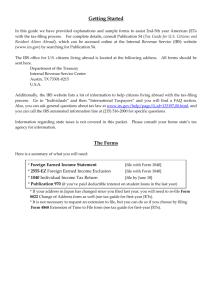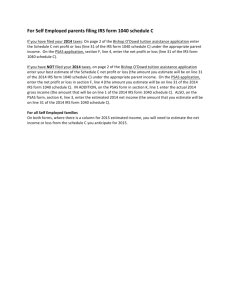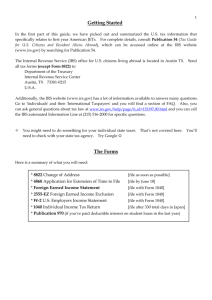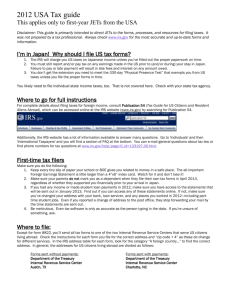2010 Tax-Year Packet for 2nd through 5th-year
advertisement
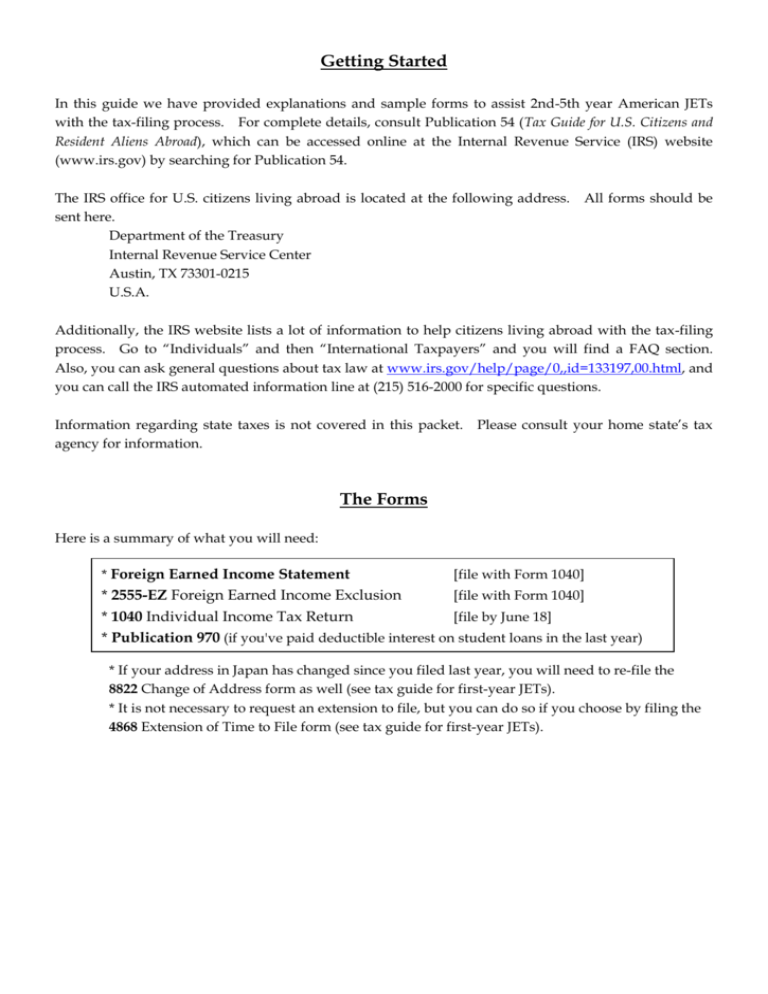
Getting Started In this guide we have provided explanations and sample forms to assist 2nd-5th year American JETs with the tax-filing process. For complete details, consult Publication 54 (Tax Guide for U.S. Citizens and Resident Aliens Abroad), which can be accessed online at the Internal Revenue Service (IRS) website (www.irs.gov) by searching for Publication 54. The IRS office for U.S. citizens living abroad is located at the following address. All forms should be sent here. Department of the Treasury Internal Revenue Service Center Austin, TX 73301-0215 U.S.A. Additionally, the IRS website lists a lot of information to help citizens living abroad with the tax-filing process. Go to “Individuals” and then “International Taxpayers” and you will find a FAQ section. Also, you can ask general questions about tax law at www.irs.gov/help/page/0,,id=133197,00.html, and you can call the IRS automated information line at (215) 516-2000 for specific questions. Information regarding state taxes is not covered in this packet. Please consult your home state’s tax agency for information. The Forms Here is a summary of what you will need: * Foreign Earned Income Statement [file with Form 1040] * 2555-EZ Foreign Earned Income Exclusion [file with Form 1040] * 1040 Individual Income Tax Return [file by June 18] * Publication 970 (if you've paid deductible interest on student loans in the last year) * If your address in Japan has changed since you filed last year, you will need to re-file the 8822 Change of Address form as well (see tax guide for first-year JETs). * It is not necessary to request an extension to file, but you can do so if you choose by filing the 4868 Extension of Time to File form (see tax guide for first-year JETs). Foreign Earned Income Statement Photocopy the small form that your school or BOE gave you showing how much money you made in 2010. It`s called the 源泉徴収票 (gensen choushuu hyou) in Japanese. If you have not received it yet, ask the accountant in your school or BOE office. This will act as a “W-2” for the income you earned in Japan. Indicate your name and your gross income on the photocopy and write “Foreign Earned Income Statement” across the top. It should look like this (example taken from GIH): Foreign Earned Income Statement 2555-EZ Foreign Earned Income Exclusion This form is used to exempt you from paying U.S. income taxes on the money you earn in Japan. Part I – You may qualify for the Bona Fide Resident Test, but the qualifications for this test are somewhat vague and difficult to understand. You will qualify for the Physical Presence Test and Tax Home Test like you did last year, so we recommend you use this qualification and not bother with the Bona Fide Resident Test. Part II – Fill in your address and employment information; write NA for Employer's U.S. address. Your employer is "other"-- put something like "foreign local government office." Follow the instructions until you get to the part that asks what your tax homes were during the tax year. In this blank, enter your address in Japan and the date (month and year) you began living there. If you moved during 2010, make sure to list your former address as well. Part III - Under Days Present in the U.S., fill in any time you spent in the U.S. during the 365-day period you specified under the “Physical Presence Test” in Part I. If you did not return to the U.S. in 2010, refer to the example below. If you returned to the U.S. during 2010, refer to the example on the next page. Part IV - Figure your Foreign Earned Income Exclusion. Where it asks for the number of days in your qualifying period that fall within 2010 (Line 14), use the 365-day period you entered under “Physical Presence Test” on the previous page. On Line 17, convert the amount listed on your Foreign Earned Income Statement to USD and enter that figure. The IRS likes everything you do to be outlined explicitly, so draw an asterisk and write, "see foreign earned income statement" at the bottom of the page. Then write a statement along the lines of: “I used the 2010 average Yen/USD exchange rate as reported by the Federal Reserve Bank to calculate the amount reported on Line 17. That rate was $1 = 87.78 Yen." And, finally, sign your name to the note. If you returned to the U.S. anytime in 2010, you must note those dates in Part III and subtract them from the number of days in your qualifying period in Part IV Line 14. Here is an example.* *Please be aware that if you returned to the U.S. for more than 35 days in 2010, you will have less than the 330 days necessary to pass the Physical Presence Test. For example, let’s say you made two 20-day trips to the U.S. in 2010, one in August and one in December. This means that in 2010, you spent only 325 days abroad (365-40=325), five short of the 330 total needed. In this case, you will need to adjust the 12-month period you entered for the Physical Presence Test in Part I to exclude enough days you were in the U.S. in order to bring your total of days abroad to 330. (This 12-month period does not have to be the 12-month period of 2010; it just has to start or end in 2010.) To exclude the December trip home, you could set the dates as December 1, 2009 – November 30, 2010. This would give you more than the 330 necessary days abroad and still give you enough days in your qualifying period (Part IV, Line 14) to exclude your JET income. 1040 Individual Income Tax Return This is the form where you report how much total money you earned in 2010. You will figure out if you get a refund or if you owe more to Uncle Sam. There are a lot of specific questions on the Form 1040 that will be different for each person. What we are explaining here is focused on the specific parts related to living and working overseas. For the rest of the complicated stuff, it’s best to start at the top and work your way through line by line. Consult a certified tax preparer and/or the official IRS instructions (online) to be sure you don't miss something. You can also call or email the IRS on their site. You also need to attach a signed statement to the 1040 stating that you are claiming the automatic 2-month extension because you reside outside the United States and your main place of business is outside the United States. Label - Exemptions – Enter your name and address information, social security #, and filing status. Claim yourself as an exemption on Line 6. Income - For “wages, salaries, and tips” on Line 7, add your income from Japan (2555-EZ Line 17) and any U.S. income (most second year plus JETs won’t have U.S. income for 2010). The “Taxable Interest” on Line 8a includes all interest earned from savings accounts. For many people, everything else is zeroes until you get to Line 21. List your Japan-earned income (2555-EZ Line 18) in parentheses on Line 21, and write “2555-EZ” next to it. Add Lines 7-20 and then subtract the amount listed on Line 21. Enter the total on Line 22 (enter “0” if the total is a negative number). This total is the amount of taxable income you earned during 2010. *These are made up numbers. You’re numbers will be different! Adjusted Gross Income - If you paid student loan interest, enter on Line 33 the amount of the “Student Loan Interest Deduction” from the worksheet in Publication 970 (available online at www.irs.gov). Many student loan institutions provide this information directly to the students. If you make payments online, check there first to see if the student loan interest is already figured out for you. Finish following the instructions for the rest of that section and turn to the next page. Everything else will be zeros for many JETs. Page 2 - Everything should be straightforward (tedious, but straightforward) on the second page. By the time you get here, you've dealt with most of the foreign earned stuff and weeded it out. Just work through the lines one by one. Use 1040 instructions page 33 to figure out your standard deduction on Line 40. Line 44 is a bit tricky. Refer to the notes below and the 1040 instructions (available online at www.irs.gov) to calculate this amount. Line 44 If Line 43 is more than zero, then you will have to calculate your tax for Line 44. If Line 43 is zero, then Line 44 will also be zero. In order to calculate your “Tax” you will have to make some calculations using the “Foreign Earned Income Tax Worksheet—Line 44” below (from page 38 of the 1040 instructions). For Lines 4 and 5 you will have to consult the 2010 Tax Table beginning on page 77 of the instructions. Finishing the 1040 - Sign and date in the box and you should be good to go. Sign and date the forms and mail them all to the IRS office in Austin by June 18. Your return will include at least Forms 1040, 2555-EZ, and the Foreign Earned Income Statement. Links to Forms 8822 Change of Address (if necessary) http://www.irs.gov/pub/irs-pdf/f8822.pdf (form and instructions) 4868 Application for Extension of Time to File (if necessary) http://www.irs.gov/pub/irs-pdf/f4868.pdf (form and instructions) 2555-EZ Foreign Earned Income Exclusion http://www.irs.gov/pub/irs-pdf/f2555ez.pdf (form) http://www.irs.gov/pub/irs-pdf/i2555ez.pdf (instructions) 1040 Individual Income Tax Return http://www.irs.gov/pub/irs-pdf/f1040.pdf (form) http://www.irs.gov/pub/irs-pdf/i1040.pdf (instructions) Publication 54 Tax Guide for U.S. Citizens and Resident Aliens Abroad http://www.irs.gov/pub/irs-pdf/p54.pdf Publication 970 Tax Benefits for Education http://www.irs.gov/pub/irs-pdf/p970.pdf Notes and Resources Other Resources: The U.S. Embassy in Japan's Tax Page http://japan.usembassy.gov/e/acs/tacs-7126b.html List of Tax Preparers in Japan http://japan.usembassy.gov/e/acs/tacs-tax2.html Contact the IRS http://www.irs.gov/help/page/0,,id=133197,00.html Individual cases and circumstances will vary. Additional procedures will be necessary if: - You are married and/or have dependants of your own - Someone else will claim you as a dependant for the 2010 tax year - You had over $10,000 in foreign bank accounts at any time during 2010 - You earn income from stocks, bonds, real estate or other investments - Any number of other circumstances This guide is in no way affiliated with the IRS or the U.S. Government. document - is the final authority on tax-related matters. The Federal Reserve Bank average annual exchange rate figure of $1 = ¥87.78 can be found at http://www.federalreserve.gov/Releases/g5a/Current/ It is your responsibility to be aware of the tax filing deadlines and to submit the forms on time. We will not remind you of the deadlines as they come, so please read through the packet carefully. We have compiled a list of frequently asked questions (and answers!) regarding the tax-filing process. These can be viewed on the PA Wiki here: http://kumamotopa.pbworks.com/US-Tax-FAQ Please do not hesitate to call or e-mail if you have any questions about the tax filing process. The IRS – not this


